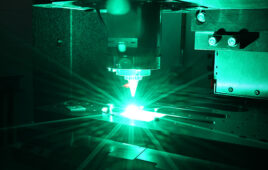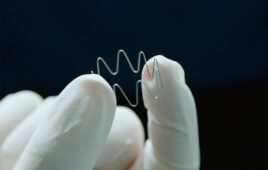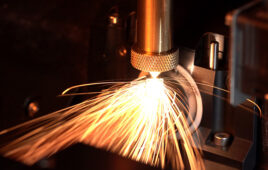Mark Szorik, MKS Instruments

NanoScan 2s is an scanning slit-beam profiler that captures and analyzes wavelengths from 190 to 950 nm. The user interface reports the measured beam characteristics. [Image courtesy of MKS Instruments]
Within a laser manufacturing process, it’s critical to know which process parameters or key control characteristics to measure and how they relate to product quality and waste. A laser profiling system can be of great benefit in this matter. It is not uncommon to discuss a user’s laser process and come to realize that they have never evaluated the quality of their beam beyond the initial delivery and assessment of their laser’s commissioning or certification document.
Many companies merely run a few test parts after the initial system set-up and, if all goes well, continue to run until bad parts inevitably crop up. When this happens, operators, process engineers, maintenance personnel and supervisors actively engage in adjusting various knobs and controls in the hopes of getting the process back to “normal.” This can go on for days before someone loses patience with the mounting scrap and its expense. This is when a frantic call goes out to a service organization to get data on what potentially went wrong, incurring further expense and extending the downtime. This approach, unfortunately, is merely a stopgap that rarely leads to the identification and permanent elimination of the problem.
A better way
Six Sigma teaches that you can ultimately control waste and lower overall cost if you map a process and understand the key variables associated with each step, along with the sources of variability associated with these variables. To reduce waste, it is paramount to understand the variables within the process and correlate these to end product specifications and suitability (fit for use). Regarding laser applications, key variables can be the beam diameter, beam tomography or modal structure, spatial power, energy density and distribution, collimation or alignment.
- Beam diameter or symmetry, also known as beam width, refers to a laser’s circular cross-section with respect to its major and minor axes. Related names include: D4 sigma, 1/e2, and 10/90 or 20/80 knife edge.Beam
- Beam tomography or modal structure refers to the 1D, 2D, and 3D profiles or aspects of a given beam.
- Spatial power is the amount of total energy or power measured with a device within a known or defined area – circle, square, ellipse, etc. Typically, power and energy measurements are taken using a power meter and an appropriate power or energy sensor head.
- Energy density is the amount of energy measured within a defined area. Like spatial power, this is typically measured using a power meter and an appropriate pyroelectric energy sensor.
- Collimation is a broad term used in many different fields that relate to lasers. It is a measure of how well aligned the laser propagating source is to the end target. Many lasers have embedded collimators in order to adjust or optimize the focus of the beam.
Understanding, measuring and correlating these variables will have a positive impact on final product quality (fit and finish) and waste reduction. Accurate process data gathered before and after a production run provides critical process knowledge and the traceability required by many industries. Waiting for a failure or relying on the final product to act as the problem indicator should be a thing of the past.
Yet many people using lasers are unaware that there are a number of tools available beyond the basic power meter and sensor combination to help measure, characterize and understand their laser output in real-time. The following summary lists a few of many profiling instruments and their capabilities.
Scanning-slit profilers: Microwatts to 1,000 of watts
NanoScan, a high accuracy instrument, measures continuous wave and kHz pulsed laser sources with beam sizes from 7µm to 6 mm, depending on power and wavelength. The device measures wavelengths from 190 nm to 100 µm. This is done by choosing 1 of 3 different single element detectors: Silicon (190 µm to 950 nm), germanium (700 nm to 1,800 nm), or pyroelectric (190 nm to 100 µm).
Once aligned with the laser source, results are instantaneous. Customizable results include beam width, centroid position, beam divergence, ellipticity, Gaussian fit, pointing stability and more. NanoScan software logs the measured data and generates charts and reports.
Because this is a scanning slit device, additional attenuation is not required in most cases. This portable device uses direct USB connectivity and so requires no external controllers or power supplies.
Camera-based profiling: Microwatts to 1,000 W
As a rule, camera-based systems include a camera, beam attenuator accessory, and software. This arrangement lets users evaluate continuous wave and pulsed sources with wavelengths from 190 nm to 3,000 µm. Cameras systems use an arrayed detector as opposed to a single element. Because these cameras have detector arrays, which are primarily a function of pixel size, they are somewhat limited as to the smallest beam they can accurately measure without additional optical enhancements. As a general rule we like to illuminate a minimum block of 10 x 10 pixels to ensure that the laser source is accurately represented.
Beam sizes from 40 µm to 4 mm can be analyzed depending on the camera and array. Most cameras have USB interfaces so they easily connect to a computer.
Non-contact: 500 W to 120 kW
BeamWatch, a high-power, non-contact, focus-spot size and position monitor, measures lasers with wavelengths between 980 nm to 1080 nm. The beauty of this instrument is that it can effectively measure laser outputs as low as 500 W, and because it’s a non-contact instrument, there is no reported upper power limit.
BeamWatch measures the signal generated from Rayleigh scattering around the laser’s beam waist. This lets users instantaneously measure the focus-spot size, focus-spot location, beam wander or shift, centroid location, beam parameter product and other key spatial and beam quality parameters. BeamWatch can be coupled to automation with tools that support various automation clients. Communication is done through a PC using GigE Ethernet connectivity.
For an output interface, BeamGage profiling software helps analyze the laser source in real time. The software comes in two versions, standard and professional. BeamGage PRO, an upgraded version of BeamGage STD, has additional sections called Automation Interface (LabVIEW, .NET VB, and Excel), Custom Calculations (programmable and user determined) and Image Partitioning. After alignment and attenuation, data acquisition is instantaneous with a high degree of resolution and accuracy.
The beam-profiling devices mentioned here provide an excellent step in understanding and controlling a process. These world-class tools are recognized and well established within the laser industry. It doesn’t take long to become proficient, and by doing so a laser operator can quickly and efficiently gather accurate and highly reproducible information.
Many industries already use laser measurement tools to conduct root-cause analysis studies, verify alignment and set-up, understand laser sub-component effects, conduct screening experiments and correlation studies, establish preventative maintenance schedules and develop process application windows. Knowing that a process is stable, consistent, predictable and capable goes a long way toward generating sustainable profit, minimizing waste and improving customer satisfaction.
Mark Szorik, the senior sales territory manager for MKS Instruments, Ophir-Spiricon Products, has worked in industrial manufacturing for more than 30 years, with experience in R&D, technical marketing, applications, sales, quality management, technical support, and product management.




